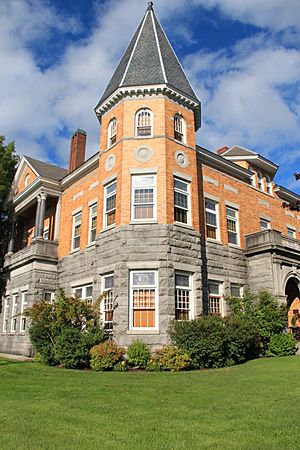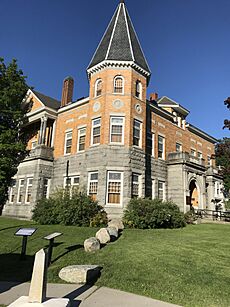Haskell Free Library and Opera House facts for kids
Quick facts for kids Haskell Free Library and Opera HouseFrench: Bibliothèque et salle d'opéra Haskell |
|
|---|---|

Haskell Free Library and Opera House in 2012
|
|
| Location | Stanstead, Quebec, Canada Derby Line, Vermont, U.S. |
| Built | 1904–1905 |
| Architect | Nate Beach & James Ball |
| Architectural style(s) | Romanesque Revival, Victorian, Queen Anne Revival |
| Official name: Haskell Free Library and Opera House National Historic Site of Canada | |
| Designated | 15 November 1985 |
| Designated | 8 September 1976 |
| Reference no. | 76000143 |
| Official name: Édifice Haskell Free Library and Opera House | |
| Type | Classified heritage immovable |
| Designated | 22 December 1977 |
| Reference no. | 93138 |
The Haskell Free Library and Opera House is a special building. It sits right on the border between Canada and the United States. You can find it in Stanstead, Quebec (Canada) and Derby Line, Vermont (U.S.).
This beautiful Victorian building opened in 1904. It was built on purpose to be on the international border. Both Canada and the U.S. have recognized it as an important historic building.
The library has two different addresses and postal codes. One is for the U.S. side, and one is for the Canadian side. It even has two different phone numbers!
Contents
A Building on the Border
This unique building was designed by architect James Ball. It has a style called Queen Anne Revival. The first floor holds the library's books and reading areas. Above that, on the second and third floors, is an opera house with 500 seats.
The library's books and the opera stage are in Canada. But the main entrance and most of the opera seats are in the United States. Because of this, people sometimes joke about the Haskell. They call it "the only library in the U.S.A. with no books." They also call it "the only opera house in the U.S.A. with no stage."
There is also an entrance on the Canadian side of the building. Before 2025, this was mainly an emergency exit. Until 2025, Canadians could use the U.S. door without going through customs. They just had to follow a special path on the sidewalk. They also had to return to Canada right after leaving the building.
Since March 2025, U.S. officials have changed the rules. Most Canadians now need to go through customs to use the main entrance. However, Canadians with a library card can still use it.
The Library's Unique Features
The library is on the first floor. It has over 20,000 books in both French and English. It is open to the public for many hours each week. French and English books are kept together on the shelves.
You can tell if a book is French or English by looking at its spine. English books usually have titles written from top to bottom. French books have titles written from bottom to top. This makes it easy to know the language right away.
A thick black line runs across the middle of the library's reading room. This line clearly shows where the Canada–United States border is.
The Opera House Experience
The opera house is on the second floor. It is said to be like a smaller version of the old Boston Opera House. It can seat about four hundred people.
The stage and half of the seats are in Canada. The rest of the opera hall is in the United States. Just like in the library, a thick black line runs under the seats. This line marks the Canada-U.S. border.
The opera hall is beautifully decorated. It has a painted scene of Venice on the main curtain. There are also other painted scenes and fancy plaster decorations. The building itself is very strong. Its walls are made of thick granite from Stanstead.
History of the Haskell
The Haskell Free Library and Opera House was a gift. It came from Martha Stewart Haskell and her son Horace "Stewart" Haskell. They built it to honor Martha's parents and her husband. The Haskell family wanted people from both Canada and the U.S. to use the building equally. That is why they chose to build it right on the border.
Construction started in 1901. The Opera House opened in 1904, and the Library opened in 1905. Later, the Haskell family gave the building to the towns of Derby Line and Rock Island. Today, a special international board manages it. This board has four American directors and three Canadian directors.
The building is officially recognized as a historic site in both countries. In the U.S., it has been on the National Register of Historic Places since 1976. In Canada, it became a provincial heritage site in 1977. It was named a National Historic Site in 1985.
After some new rules for visitors were put in place in January 2017, the library became a special meeting spot. Families from different countries could meet there. This was because the building is partly in Canada and partly in the U.S. A play called A Distinct Society is even based on these family meetings. However, official family reunions and cross-border visits are no longer allowed.
In January 2018, a man was found guilty of illegal activities. He had brought items from Vermont into Quebec in 2010 and 2011. He and others had hidden these items in the library's bathroom.
The library closed in March 2020 because of the COVID-19 pandemic. It did not fully reopen until spring 2022.
In March 2025, the U.S. government announced new rules. Starting October 1, Canadians would need to pass through customs to use the main entrance. Before this, only Canadians with a library card or staff could use that entrance. U.S. officials said these changes were for security. However, the library's leaders said there had been very few security problems.
In response, the library planned to fix up an entrance on the Canadian side. An emergency door was also reopened for Canadians who are not members. The library also started raising money for a new, easy-to-access entrance on the Canadian side. A famous author, Louise Penny, made a big donation. The library hoped to raise CA$100,000 but collected CA$170,000 in just one week!
Other Borderline Places
- Line house: A building that sits on an international border.
- Baarle-Nassau and Baarle-Hertog: Two towns with a very complex border between the Netherlands and Belgium.
- La Cure: A village divided between Switzerland and France. A hotel there is split by the border!



